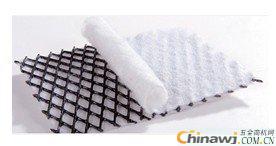The composite drainage network is a new type of drainage geotechnical material. It is made of high-density polyethylene (HDPE) and processed by a special extrusion process. It has a special structure of three layers. The intermediate ribs are rigid and longitudinally arranged to form drainage channels. The ribs arranged in the upper and lower crosses form a support to prevent the geotextile from being embedded in the drainage channel, and maintain high drainage performance even under high loads. The double-sided adhesive water-permeable geotextile is used in combination, and has the comprehensive performance of “filter-drainage--breathing-protectionâ€, which is the most ideal drainage material at present.
1. Laid between the foundation and the foundation to drain water between the foundation and the foundation, block the capillary water and effectively integrate it into the edge drainage system. This structure automatically shortens the drainage path of the foundation, the drainage time is greatly shortened, and the amount of selected foundation materials can be reduced (i.e., materials with more fine materials and lower permeability) can be used. Can extend the life of the road.
2. Laying the drainage net on the base layer can prevent the base fine material from entering the ground layer (that is, it acts as an isolation). The aggregate base layer will enter the upper part of the geonet to a limited extent. Thus, the composite geotechnical drainage network also has a potential to limit the lateral movement of the aggregate base layer. In this way, its function is similar to the reinforcement of the geogrid. In general, the tensile strength and rigidity of a composite geotechnical drainage net is superior to many geogrids used for foundation reinforcement, and this limitation will increase the support capacity of the foundation.
3. After the road is aged and cracks are formed, most of the rainwater will enter the section. In this case, the composite drainage net is laid directly under the road surface instead of the drainable foundation. The drainage network can collect moisture before it enters the foundation/subbase. It is also possible to wrap a film on the bottom end of the drainage net to further prevent moisture from entering the foundation.
For rigid road systems, this configuration allows the design of roads with a higher drainage coefficient, Cd. Another advantage of this construction is that it may be possible to hydrate the concrete more uniformly (research is ongoing on the extent of this advantage). Whether it is for rigid roads or flexible road systems, this structure can extend the life of the road.
4. Under the climatic conditions in the north, laying drainage nets can help mitigate the effects of frost heaving. If the depth of freezing is deep, the geonet can be laid in a shallow position in the base to block as a capillary action. In addition, it is often necessary to replace it with a non-frozen granular sub-base and extend down to the depth of freezing. The easy-frozen backfill can be directly filled in the drainage network until the ground line. In this case, the system can be connected to the drain outlet so that the water table is at or below this depth. This can potentially limit the development of ice crystals, and there is no need to limit traffic loads during spring ice melt in cold regions.
5. Geotechnical composite drainage network for landfills: In landfills, geotechnical composite drainage network http:// can be used for groundwater drainage layer leakage detection layer leachate collection and drainage layer sealing field gas collection guide Leachate sealing site surface water collection and drainage landfill leachate drainage layer and leakage detection layer: To prevent leakage of the lining system and ensure the safety of the landfill, the leachate drainage system must have reliable drainage Performance, the leachate collected by the discharge liner system ensures that the saturated leachate of the liner leachate is less than the thickness of the drainage layer. Traditional drainage materials such as sand and gravel are used for leachate collection and drainage of landfills, which will occupy a large landfill space.
For slope leachate guides, the use of sand and gravel will be difficult to stack. The use of geotechnical composite drainage nets is basically independent of the slope of the slope. The gravel is used as a leachate to collect the drainage layer, which will cause damage to the anti-seepage geomembrane. According to statistics, the placement of gravel on the geomembrane is the biggest cause of geomembrane damage, accounting for more than 70% of the total damage.
The three-dimensional geocomposite drainage network has a three-dimensional spatial three-dimensional guide structure, which uses a high-permeability geotextile composite to maintain long-term drainage performance under extremely high loads, and is used for the main leachate collection and drainage layer (LCRS). The leachate of the anti-seepage membrane is discharged in time, so that the water head is smaller than the thickness of the geotechnical drainage material, and the leakage of the geomembrane caused by the excessive head is reduced.

Wheel Buckle Accessories,Stroller Wheels,Crib Parts ,Graco Stroller Parts
Guangzhou ZG Scaffolding.co.Ltd , http://www.zgscaffolding.com
